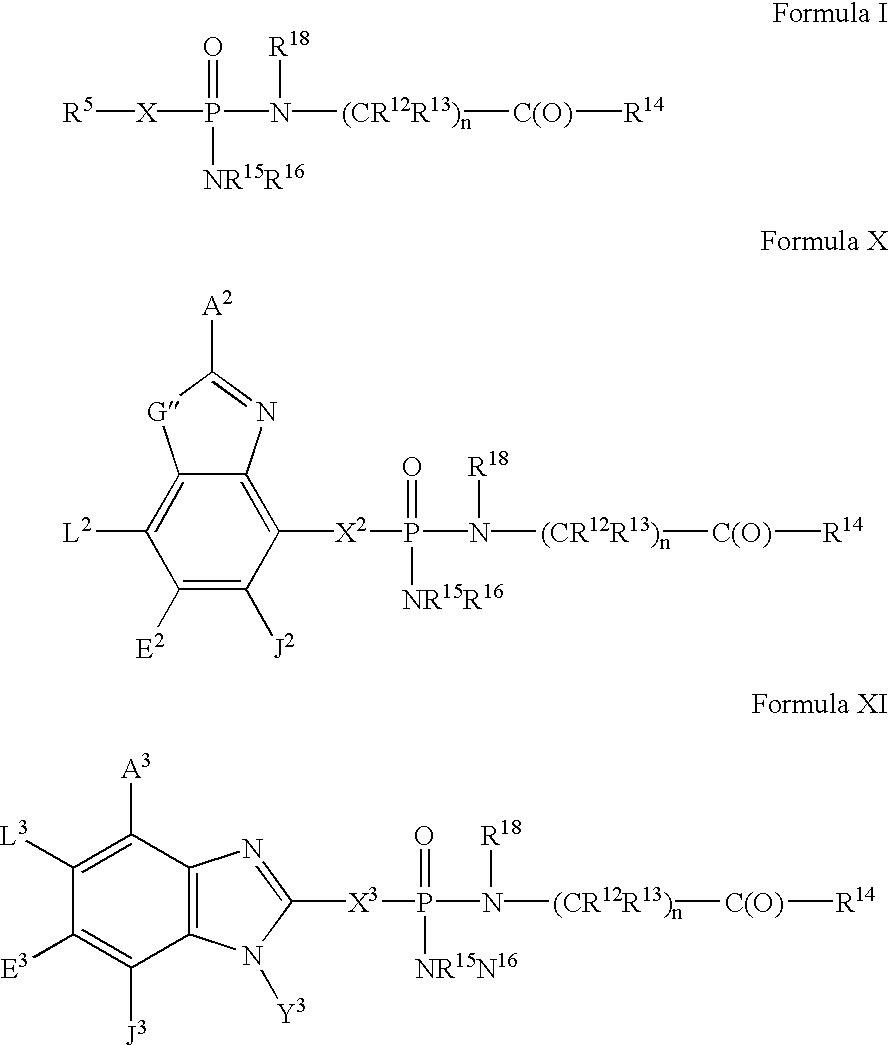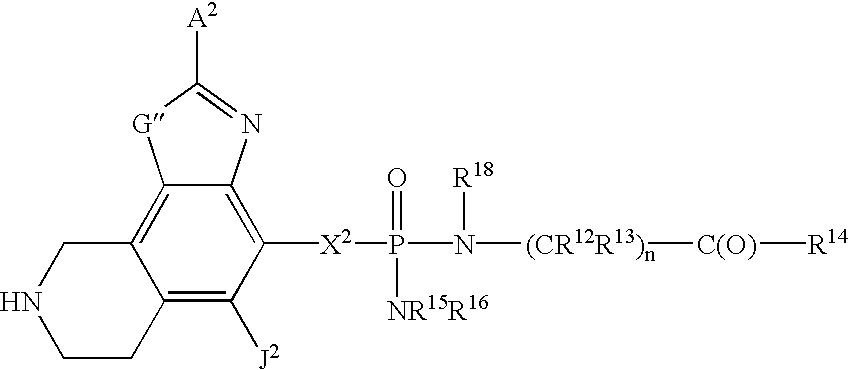Bisamidate phosphonate prodrugs
a phosphonate prodrug and bisamidate technology, applied in the field of new drugs, can solve the problems of poor oral bioavailability, poor oral bioavailability, and limited oral bioavailability of organic compounds charged at physiological ph, and achieve less success with other classes of phosphonate prodrugs
- Summary
- Abstract
- Description
- Claims
- Application Information
AI Technical Summary
Benefits of technology
Problems solved by technology
Method used
Image
Examples
example 1
Preparation of 5-diethylnhosphono-2-furaldehyde (1)
Step A.
[0311]A solution of 2-furaldehyde diethyl acetal (1 mmole) in THF (tetrahydrofuran) was treated with nBuLi (1 mmole) at −78° C. After 1 h, diethyl chlorophosphate (1.2 mmole) was added and the reaction was stirred for 40 min. Extraction and evaporation gave a brown oil.
Step B.
[0312]The resulting brown oil was treated with 80% acetic acid at 90° C. for 4 h. Extraction and chromatography gave compound 1 as a clear yellow oil. Alternatively this aldehyde can be prepared from furan as described below.
Step C.
[0313]A solution of furan (1 mmole) in diethyl ether was treated with TMEDA (N,N,N′N′-tetramethylethylenediamine) (1 mmole) and nBuLi (2 mmole) at −78° C. for 0.5 h. Diethyl chlorophosphate (1.2 mmole) was added to the reaction mixture and stirred for another hour. Extraction and distillation gave diethyl 2-furanphosphonate as a clear oil.
Step D.
[0314]A solution of diethyl 2-furanphosphonate (1 mmole) in TBF was treated with L...
example 2
Preparation of 5-diethylphosphono-2-1[(1-oxo)alkyl]furans and 6-diethylphosphono-2-[(1-oxo)alkyl]pyridines
Step A.
[0318]A solution of furan (1.3 mmole) in toluene was treated with 4-methyl pentanoic acid (1 mmole), trifluoroacetic anhydride (1.2 mmole) and boron trifluoride etherate (0.1 mmole) at 56° C. for 3.5 h. The cooled reaction mixture was quenched with aqueous sodium bicarbonate (1.9 mmole), filtered through a celite pad. Extraction, evaporation and distillation gave 2-[(4-methyl-1-oxo)pentyl]furan as a brown oil (bp 65-77° C., 0.1 mm Hg).
Step B.
[0319]A solution of 2-[(4-methyl-1-oxo)pentyl]furan (1 mmole) in benzene was treated with ethylene glycol (2.1 mmole) and p-toluenesulfonic acid (0.05 mmole) at reflux for 60 h while removing water via a Dean-Stark trap. Triethyl orthoformate (0.6 mmole) was added and resulting mixture was heated at reflux for an additional hour. Extraction and evaporation gave 2-(2-furanyl)-2-[(3-methyl)butyl]-1,3-dioxolane as an orange liquid.
Step C...
example 3
Preparation of 4-[2-(5-phosphono)furanyl]thiazoles. 4-[2-(6-phosphono)pyridyl]thiazoles and 4-[2-(5-phosphono)furanyl]selenazoles
Step A.
[0336]A solution of compound 2.1 (1 mmole) in ethanol was treated with copper (II) bromide (2.2 mmole) at reflux for 3 h. The cooled reaction mixture was filtered and the filtrate was evaporated to dryness. The resulting dark oil was purified by chromatography to give 5-diethylphosphono-2-[(2-bromo-4-methyl-1-oxo)pentyl]furan as an orange oil.
Step B.
[0337]A solution of 5-diethylphosphono-2-[(2-bromo-4-methyl-1-oxo)pentyl]furan (1 mmole) and thiourea (2 mmole) in ethanol was heated at reflux for 2 h. The cooled reaction mixture was evaporated to dryness and the resulting yellow foam was suspended in saturated sodium bicarbonate and water (pH=8). The resulting yellow solid was collected through filtration to give 2-amino-5-isobutyl-4-[2-(5-diethylphosphono)furanyl]thiazole.
Step C.
[0338]A solution of 2-amino-5-isobutyl-4-[2-(5-diethylphosphono)-furanyl...
PUM
 Login to View More
Login to View More Abstract
Description
Claims
Application Information
 Login to View More
Login to View More - R&D
- Intellectual Property
- Life Sciences
- Materials
- Tech Scout
- Unparalleled Data Quality
- Higher Quality Content
- 60% Fewer Hallucinations
Browse by: Latest US Patents, China's latest patents, Technical Efficacy Thesaurus, Application Domain, Technology Topic, Popular Technical Reports.
© 2025 PatSnap. All rights reserved.Legal|Privacy policy|Modern Slavery Act Transparency Statement|Sitemap|About US| Contact US: help@patsnap.com



